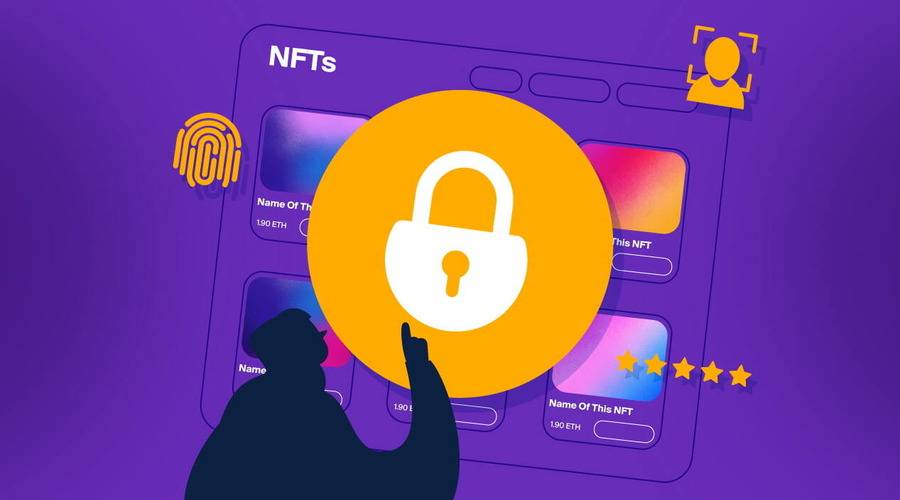Security Measures for NFT Marketplaces

Security Measures for NFT Marketplaces
In today’s digital landscape, Non-Fungible Tokens (NFTs) have gained significant popularity. These unique digital assets are becoming increasingly valuable, attracting investors, collectors, and artists alike. However, as the NFT market continues to grow, so does the need for robust security measures to protect users and their assets. This article will delve into the importance of security in NFT marketplaces and explore various measures that can be implemented to safeguard these valuable digital assets.
Introduction to NFT
As the world embraces the digital revolution, NFTs have emerged as a groundbreaking concept in the realm of blockchain technology. NFTs represent one-of-a-kind digital assets that can be bought, sold, and traded using cryptocurrency. With their unique properties, NFTs have revolutionized the art and collectibles industry, providing a new way for creators to monetize their work and for collectors to own exclusive digital items.
Understanding NFTs
To fully comprehend the significance of security measures in NFT marketplaces, it is essential to understand the underlying technology. NFTs are created and stored on blockchain networks, most commonly on Ethereum. Each NFT has a distinct identifier that distinguishes it from other tokens, making it non-interchangeable and unique.
The Popularity of NFT Marketplaces
NFT marketplaces have experienced an exponential rise in popularity, attracting a wide range of participants. Artists, musicians, athletes, and celebrities are leveraging these platforms to showcase and sell their digital creations, while collectors are investing in these assets with the expectation of future returns. This surge in interest has led to a surge in cyber threats targeting these marketplaces.
Importance of Security in NFT Marketplaces
The decentralized and transparent nature of blockchain technology makes it appealing for NFT transactions. However, it also poses security challenges that need to be addressed. Ensuring the security of NFT marketplaces is crucial to protect the assets and interests of both creators and collectors. Without proper security measures, NFT marketplaces can become vulnerable to various threats, including hacking, fraud, and theft.
Types of Security Threats in NFT Marketplaces
NFT marketplaces face a range of security threats that can compromise the integrity and value of digital assets. Some common threats include:
- Phishing Attacks: Cybercriminals may impersonate legitimate platforms to deceive users into revealing their private keys or other sensitive information.
- Smart Contract Vulnerabilities: Flaws in smart contracts can lead to exploits, allowing attackers to manipulate or steal NFTs.
- Malware and Keyloggers: Malicious software can compromise users’ devices, enabling attackers to gain unauthorized access to wallets and private keys.
- Insider Threats: Individuals with access to the marketplace’s infrastructure may abuse their privileges and compromise the security of the platform.
- Fake NFT Listings: Scammers may create counterfeit NFTs or sell stolen assets, deceiving unsuspecting buyers.
Best Practices for Secure NFT Transactions

To mitigate these security threats, NFT marketplaces should implement robust security measures. Here are some best practices to ensure secure NFT transactions:
- Implementing Robust Authentication Mechanisms: Two-factor authentication (2FA) and biometric authentication can add an extra layer of security to user accounts, reducing the risk of unauthorized access.
- Utilizing Secure Wallets: Encouraging users to store their NFTs in hardware wallets or well-established software wallets can significantly enhance security.
- Smart Contract Audits: Regular audits reputable security firms can help identify and address vulnerabilities in smart contracts, reducing the risk of exploitation.
- KYC and AML Procedures: Implementing Know Your Customer (KYC) and Anti-Money Laundering (AML) procedures can help prevent fraudulent activities and ensure compliance with regulations.
- Multi-factor Authentication: Enabling multi-factor authentication for transactions can provide an additional layer of security, requiring users to verify their identity through multiple means.
- Secure Marketplace Infrastructure: Employing robust security protocols, encryption mechanisms, and regular software updates can protect the platform from external threats.
- Educating Users about Security: Providing educational resources and guidelines on secure practices can empower users to protect themselves from potential threats.
- Regular Security Assessments: Conducting regular security assessments, including penetration testing and vulnerability scanning, can help identify and address security weaknesses proactively.
Educating Users about Security
One of the key aspects of maintaining a secure environment in NFT marketplaces is educating users about security best practices. Many users may be new to the world of blockchain technology and NFTs, making them susceptible to potential risks. By providing clear and concise educational resources, platforms can empower users to protect themselves and their assets. Here are some essential points to cover when educating users:
- Importance of Secure Passwords: Emphasize the significance of creating strong, unique passwords for their NFT marketplace accounts. Encourage the use of password managers to generate and store complex passwords securely.
- Recognizing Phishing Attempts: Educate users about the risks of phishing attacks and provide examples of common phishing techniques. Teach them to verify the authenticity of emails, links, and websites before entering sensitive information.
- Securing Personal Devices: Inform users about the importance of keeping their devices, including smartphones, computers, and hardware wallets, secure and up to date. Encourage the use of reputable antivirus software and regular software updates to protect against malware and other potential threats.
- Safe Wallet Practices: Educate users on the different types of wallets available, such as hardware wallets, software wallets, and online wallets. Explain the advantages and potential risks associated with each option, and guide them on selecting a wallet that meets their security needs.
- Social Engineering Awareness: Raise awareness about social engineering techniques used cybercriminals to trick users into revealing sensitive information. Teach users to be cautious of unsolicited messages, suspicious links, and requests for personal information.
- Regular Security Checks: Encourage users to review their account activity periodically, check for any suspicious transactions, and report any anomalies immediately. Stress the importance of maintaining a proactive approach to security.
- Staying Informed: Advise users to stay updated on the latest security news, trends, and potential threats in the NFT space. Recommend reputable sources for obtaining accurate information, such as official platform announcements, security blogs, and industry news.
By educating users about these essential security practices, NFT marketplaces can create a more secure ecosystem where users are aware of potential risks and actively take steps to protect themselves and their digital assets.
Regular Security Assessments
To maintain a high level of security in NFT marketplaces, regular security assessments should be conducted. These assessments help identify potential vulnerabilities, weaknesses, and areas for improvement within the platform’s infrastructure and systems. Here are some key elements to consider when performing security assessments:
- Penetration Testing: Hire experienced cybersecurity professionals to conduct penetration testing, simulating real-world attacks to identify vulnerabilities in the platform’s security defenses. This allows for proactive remediation of potential weaknesses.
- Vulnerability Scanning: Utilize automated vulnerability scanning tools to identify common security issues, such as outdated software versions, misconfigurations, or known vulnerabilities. Regular scanning helps ensure that security patches and updates are promptly applied.
- Code Review: Perform thorough code reviews of the platform’s software, including smart contracts, to identify any potential security flaws or coding errors. Engage security experts to review the code and provide recommendations for improvements.
- Third-Party Audits: Consider engaging external security firms or auditors to conduct comprehensive security audits. These audits can provide an unbiased assessment of the platform’s security posture and offer valuable insights into potential vulnerabilities.
- Incident Response Planning: Develop a robust incident response plan that outlines the steps to be taken in the event of a security incident. This plan should include procedures for containment, investigation, and recovery to minimize potential damages.
By regularly assessing the security of NFT marketplaces, potential vulnerabilities can be identified and mitigated proactively, ensuring a safer environment for users and their valuable digital assets.
Conclusion
In conclusion, ensuring the security of NFT marketplaces is paramount in protecting the interests of users and the integrity of digital assets. As the popularity of NFTs continues to soar, so does the need for robust security measures. By implementing best practices such as strong authentication mechanisms, secure wallets, smart contract audits, and user education, NFT marketplaces can create a safe environment for transactions.
However, it is important to acknowledge that the security landscape is constantly evolving. Cyber threats are becoming more sophisticated, and new vulnerabilities may arise. Therefore, it is crucial for NFT marketplaces to stay vigilant, keep up with the latest security practices, and adapt to emerging risks. Regular security assessments, including penetration testing and vulnerability scanning, can help identify and address vulnerabilities promptly.
By prioritizing security and fostering trust among users, NFT marketplaces can support the growth and sustainability of the NFT ecosystem. This will attract more participants, including creators, collectors, and investors, and ensure a positive and secure experience for all stakeholders.
FAQs
- Are NFT transactions secure?
- NFT transactions can be secure if proper security measures are implemented. This includes using secure wallets, enabling multi-factor authentication, and conducting regular security assessments.
- What are the risks of using NFT marketplaces?
- The risks of using NFT marketplaces include phishing attacks, smart contract vulnerabilities, malware and keyloggers, insider threats, and fake NFT listings.
- How can I protect my NFTs from theft?
- You can protect your NFTs from theft using secure wallets, implementing strong authentication mechanisms, and being cautious of phishing attempts.
- What is the importance of smart contract audits?
- Smart contract audits help identify vulnerabilities in the code of NFTs, ensuring they are secure and less prone to exploitation attackers.
- Why is educating users about security crucial in NFT marketplaces?
- Educating users about security is crucial to raise awareness about potential threats and empower them to make informed decisions to protect their digital assets.
I’ve been involved with cryptocurrency for three years. I have been a vocal advocate for the people and an active part of the community. I am well-known for my book “Crypto Revolution: An Insider’s Guide to the Future of Money” and blog “The Crypto Chronicles.” In addition, I frequently contribute to CoinDesk, one of the top news websites for cryptocurrencies. I write as well as invest actively in a number of bitcoin initiatives.
